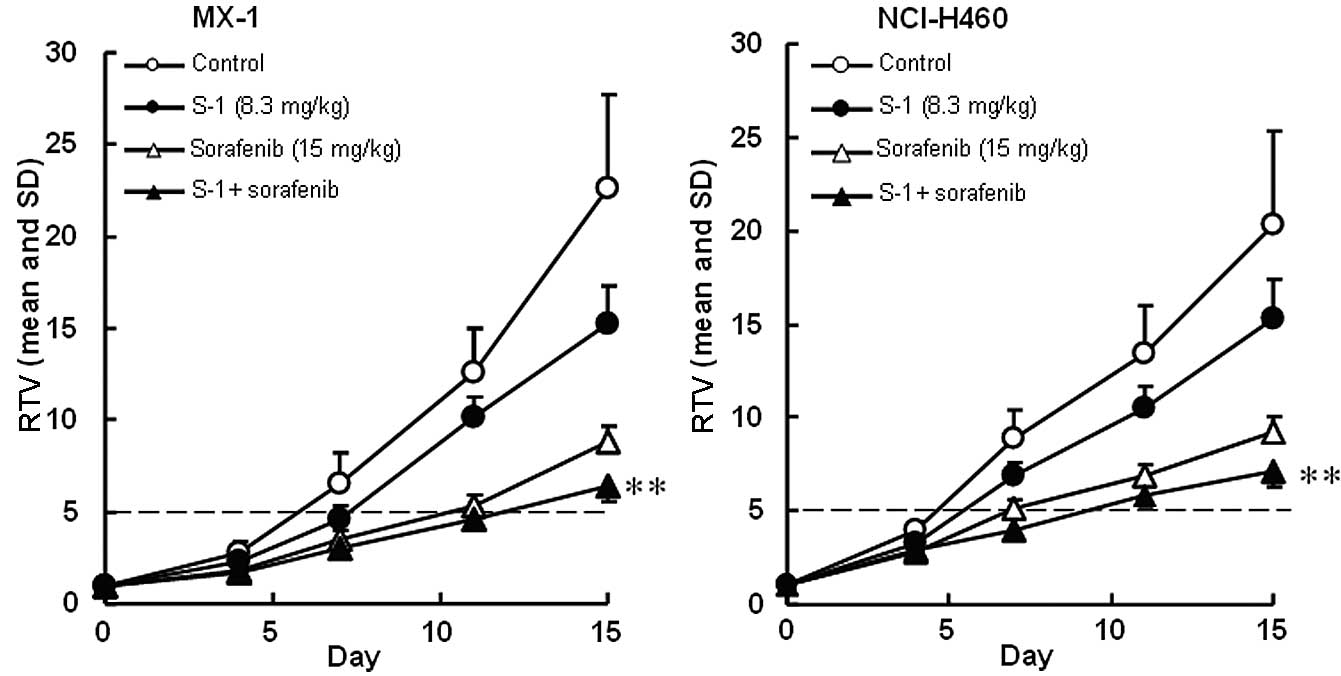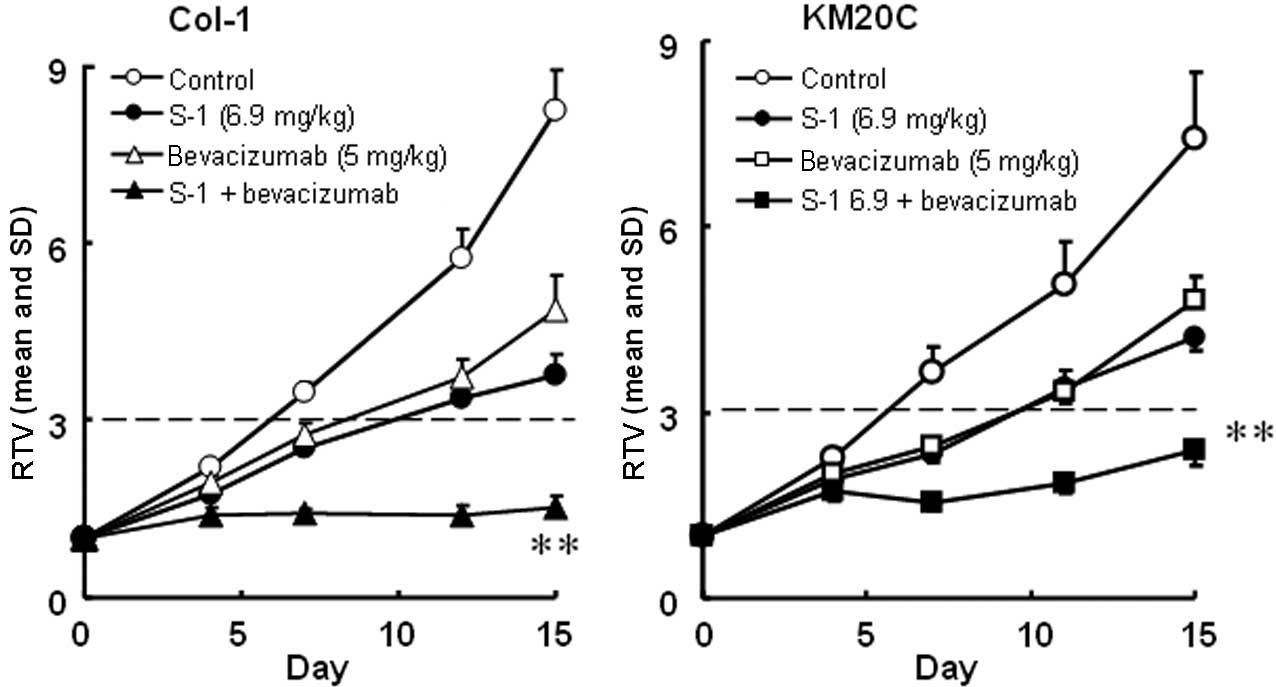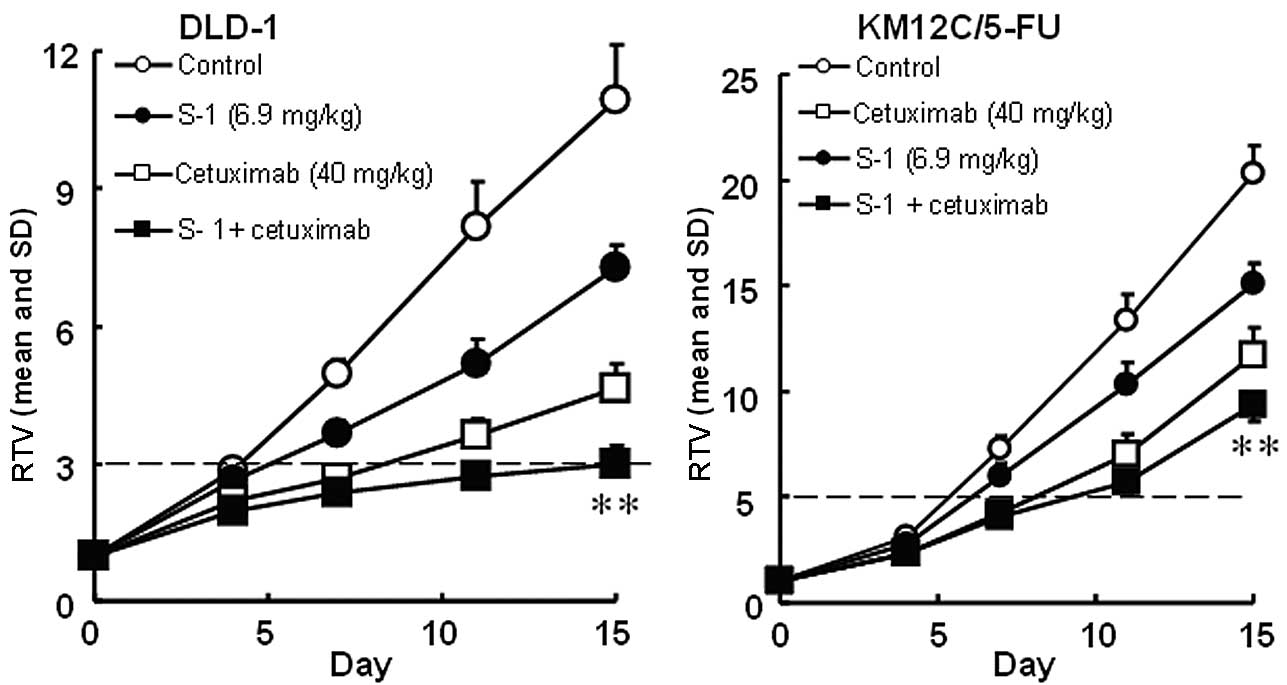|
1.
|
Popov I, Milicević M and Radosević-Jelić
LJ: The addition of bevacizumab to fluoropyrimidine, irinotecan and
oxaliplatin-based therapy improves survival for patients with
metastatic colorectal cancer (CRC): combined analysis of efficacy.
Acta Chir Iugosl. 55:11–16. 2008. View Article : Google Scholar
|
|
2.
|
Meyerhardt JA, Stuart K, Fuchs CS, Zhu AX,
Earle CC, Bhargava P, Blaszkowsky L, Enzinger P, Mayer RJ, Battu S,
et al: Phase II study of FOLFOX, bevacizumab and erlotinib as
first-line therapy for patients with metastatic colorectal cancer.
Ann Oncol. 18:1185–1189. 2007. View Article : Google Scholar : PubMed/NCBI
|
|
3.
|
Boccia RV, Cosgriff TM, Headley DL,
Badarinath S and Dakhil SR: A phase II trial of FOLFOX6 and
cetuximab in the first-line treatment of patients with metastatic
colorectal cancer. Clin Colorectal Cancer. 9:102–107. 2010.
View Article : Google Scholar : PubMed/NCBI
|
|
4.
|
Townsley CA, Major P, Siu LL, Dancey J,
Chen E, Pond GR, Nicklee T, Ho J, Hedley D, Tsao M, et al: Phase II
study of erlotinib (OSI-774) in patients with metastatic colorectal
cancer. Br J Cancer. 94:1136–43. 2006. View Article : Google Scholar : PubMed/NCBI
|
|
5.
|
Dal Lago L, D’Hondt V and Awada A:
Selected combination therapy with sorafenib: a review of clinical
data and perspectives in advanced solid tumors. Oncologist.
13:845–858. 2008.PubMed/NCBI
|
|
6.
|
Shirasaka T, Nakano K, Takechi T, Satake
H, Uchida J, Fujioka A, Saito H, Okabe H, Oyama K, Takeda S, et al:
Antitumor activity of 1 M tegafur-0.4 M
5-chloro-2,4-dihydroxypyridine-1 M potassium oxonate (S-1) against
human colon carcinoma orthotopically implanted into nude rats.
Cancer Res. 56:2602–2606. 1996.
|
|
7.
|
Fukushima M, Satake H, Uchida J, Shimamoto
Y, Kato T, Takechi T, Okabe H, Fujioka A, Nakano K, Ohshimo H, et
al: Preclinical antitumor efficacy of S-1: A new oral formulation
of 5-fluorouracil on human tumor xenografts. Int J Oncol.
13:693–698. 1998.PubMed/NCBI
|
|
8.
|
Sakata Y, Ohtsu A, Horikoshi N, Sugimachi
K, Mitachi Y and Taguchi T: Late phase II study of novel oral
fluoropyrimidine anticancer drug S-1 (1 M tegafur-0.4 M gimestat-1
M otastat potassium) in advanced gastric cancer patients. Eur J
Cancer. 34:1715–1720. 1998. View Article : Google Scholar : PubMed/NCBI
|
|
9.
|
Ohtsu A, Baba H, Sakata Y, Mitachi Y,
Horikoshi N, Sugimachi K and Taguchi T: Phase II study of S-1, a
novel oral fluoropyrimidine derivative, in patients with metastatic
colorectal carcinoma. Br J Cancer. 83:141–145. 2000.PubMed/NCBI
|
|
10.
|
Saeki T, Takashima S, Sano M, Horikoshi N,
Miura S, Shimizu S, Morimoto K, Kimura M, Aoyama H, Ota J, et al: A
phase II study of S-1 in patients with metastatic breast cancer - a
Japanese trial by the S-1 Cooperative Study Group, Breast Cancer
Working Group. Breast Cancer. 11:194–202. 2002. View Article : Google Scholar : PubMed/NCBI
|
|
11.
|
Muro K, Boku N, Shimada Y, Tsuji A,
Sameshima S, Baba H, Satoh T, Denda T, Ina K, Nishina T, et al:
Irinotecan plus S-1 (IRIS) versus fluorouracil and folinic acid
plus irinotecan (FOLFIRI) as second-line chemotherapy for
metastatic colorectal cancer: a randomised phase 2/3
non-inferiority study (FIRIS study). Lancet Oncol. 11:853–860.
2010. View Article : Google Scholar : PubMed/NCBI
|
|
12.
|
Nakashima K, Hironaka S, Boku N, Onozawa
Y, Fukutomi A, Yamazaki K, Yasui H, Taku K, Kojima T and Machida N:
Irinotecan plus cisplatin therapy and S-1 plus cisplatin therapy
for advanced or recurrent gastric cancer in a single institution.
Jpn J Clin Oncol. 38:810–815. 2008. View Article : Google Scholar : PubMed/NCBI
|
|
13.
|
Koizumi W, Tanabe S, Saigenji K, Ohtsu A,
Boku N, Nagashima F, Shirao K, Matsumura Y and Gotoh M: Phase I/II
study of S-1 combined with cisplatin in patients with advanced
gastric cancer. Br J Cancer. 89:2207–2212. 2003. View Article : Google Scholar : PubMed/NCBI
|
|
14.
|
Narahara H, Fujitani K, Takiuchi H,
Sugimoto N, Inoue K, Uedo N, Tsukuma H, Tsujinaka T, Furukawa H and
Taguchi T: Phase II study of a combination of S-1 and paclitaxel in
patients with unresectable or metastatic gastric cancer. Oncology.
74:37–41. 2008. View Article : Google Scholar : PubMed/NCBI
|
|
15.
|
Ishigami H, Kitayama J, Kaisaki S,
Hidemura A, Kato M, Otani K, Kamei T, Soma D, Miyato H, Yamashita H
and Nagawa H: Phase II study of weekly intravenous and
intraperitoneal paclitaxel combined with S-1 for advanced gastric
cancer with peritoneal metastasis. Ann Oncol. 21:67–70. 2010.
View Article : Google Scholar : PubMed/NCBI
|
|
16.
|
Okabe T, Okamoto I, Tsukioka S, Uchida J,
Hatashita E, Yamada Y, Yoshida T, Nishio K, Fukuoka M, Jänne PA and
Nakagawa K: Addition of S-1 to the epidermal growth factor receptor
inhibitor gefitinib overcomes gefitinib resistance in non-small
cell lung cancer cell lines with MET amplification. Clin Cancer
Res. 15:907–913. 2009. View Article : Google Scholar
|
|
17.
|
Tanizaki J, Okamoto I, Takezawa K,
Tsukioka S, Uchida J, Kiniwa M, Fukuoka M and Nakagawa K:
Synergistic antitumor effect of S-1 and HER2-targeting agents in
gastric cancer with HER2 amplification. Mol Cancer Ther.
9:1198–1207. 2010. View Article : Google Scholar : PubMed/NCBI
|
|
18.
|
Fukushima M, Fujioka A, Uchida J, Nakagawa
F and Takechi T: Thymidylate synthase (TS) and ribonucleotide
reductase (RNR) may be involved in acquired resistance to
5-fluorouracil (5-FU) in human cancer xenografts in vivo. Eur J
Cancer. 37:1681–1687. 2001. View Article : Google Scholar : PubMed/NCBI
|
|
19.
|
Ikediobi ON, Davies H, Bignell G, Edkins
S, Stevens C, O’Meara S, Santarius T, Avis T, Barthorpe S,
Brackenbury L, et al: Mutation analysis of 24 known cancer genes in
the NCI-60 cell line set. Mol Cancer Ther. 5:2606–2612. 2006.
View Article : Google Scholar : PubMed/NCBI
|
|
20.
|
Higgins B, Kolinsky K, Smith M, Beck G,
Rashed M, Adames V, Linn M, Wheeldon E, Gand L, Birnboeck H and
Hoffmann G: Antitumor activity of erlotinib (OSI-774, Tarceva)
alone or in combination in human non-small cell lung cancer tumor
xenograft models. Anticancer Drugs. 15:503–512. 2004. View Article : Google Scholar : PubMed/NCBI
|
|
21.
|
Arao T, Fukumoto H, Takeda M, Tamura T,
Saijo N and Nishio K: Small in-frame deletion in the epidermal
growth factor receptor as a target for ZD6474. Cancer Res.
64:9101–9104. 2004. View Article : Google Scholar : PubMed/NCBI
|
|
22.
|
Prewett MC, Hooper AT, Bassi R, Ellis LM,
Waksal HW and Hicklin DJ: Enhanced antitumor activity of
anti-epidermal growth factor receptor monoclonal antibody IMC-C225
in combination with irinotecan (CPT-11) against human colorectal
tumor xenografts. Clin Cancer Res. 8:994–1003. 2002.
|
|
23.
|
Fox WD, Higgins B, Maiese KM, Drobnjak M,
Cordon-Cardo C, Scher HI and Agus DB: Antibody to vascular
endothelial growth factor slows growth of an androgen-independent
xenograft model of prostate cancer. Clin Cancer Res. 8:3226–3231.
2002.PubMed/NCBI
|
|
24.
|
Balin-Gauthier D, Delord JP, Rochaix P,
Mallard V, Thomas F, Hennebelle I, Bugat R, Canal P and Allal C: In
vivo and in vitro antitumor activity of oxaliplatin in combination
with cetuximab in human colorectal tumor cell lines expressing
different level of EGFR. Cancer Chemother Pharmacol. 7:709–718.
2006. View Article : Google Scholar
|
|
25.
|
Bauer P, Röhmel J, Maurer W and Hothorn L:
Testing strategies in multi-dose experiments including active
control. Stat Med. 17:2133–2146. 1988. View Article : Google Scholar : PubMed/NCBI
|
|
26.
|
Malet-Martino M and Martino R: Clinical
studies of three oral prodrugs of 5-fluorouracil (capecitabine,
UFT, S-1): a review. Oncologist. 288–323. 2002. View Article : Google Scholar : PubMed/NCBI
|
|
27.
|
Peters GJ, van der Wilt CL, van Triest B,
Codacci-Pisanelli G, Johnston PG, van Groeningen CJ and Pinedo HM:
Thymidylate synthase and drug resistance. Eur J Cancer.
31A:1299–1305. 1995. View Article : Google Scholar : PubMed/NCBI
|
|
28.
|
Kadota K, Huang CL, Liu D, Yokomise H,
Haba R and Wada H: Combined therapy with a thymidylate
synthase-inhibiting vector and S-1 has effective antitumor activity
against 5-FU-resistant tumors. Int J Oncol. 38:355–363.
2011.PubMed/NCBI
|
|
29.
|
Skvortsov S, Sarg B, Lindner H, Lukas P,
Hilbe W, Zwierzina H and Skvortsova I: Cetuximab inhibits
thymidylate synthase in colorectal cells expressing epidermal
growth factor receptor. Proteomics Clin Appl. 2:908–914. 2008.
View Article : Google Scholar : PubMed/NCBI
|
|
30.
|
Giovannetti E, Lemos C, Tekle C, Smid K,
Nannizzi S, Rodriguez JA, Ricciardi S, Danesi R, Giaccone G and
Peters GJ: Molecular mechanisms underlying the synergistic
interaction of erlotinib, an epidermal growth factor receptor
tyrosine kinase inhibitor, with the multitargeted antifolate
pemetrexed in non-small-cell lung cancer cells. Mol Pharmacol.
73:1290–1300. 2008. View Article : Google Scholar
|
|
31.
|
Takeuchi A, Shiota M, Tatsugami K,
Yokomizo A, Eto M, Inokuchi J, Kuroiwa K, Kiyoshima K and Naito S:
Sorafenib augments cytotoxic effect of S-1 in vitro and in vivo
through TS suppression. Cancer Chemother Pharmacol. 68:1557–1564.
2011. View Article : Google Scholar : PubMed/NCBI
|
|
32.
|
Carloni S, Fabbri F, Brigliadori G, Ulivi
P, Silvestrini R, Amadori D and Zoli W: Tyrosine kinase inhibitors
gefitinib, lapatinib and sorafenib induce rapid functional
alterations in breast cancer cells. Curr Cancer Drug Targets.
10:422–431. 2010. View Article : Google Scholar
|
|
33.
|
Kobunai T, Watanabe T and Fukusato T:
Antitumor activity of S-1 in combination with cetuximab on human
gastric cancer cell lines in vivo. Anticancer Res. 31:3691–3696.
2011.PubMed/NCBI
|
|
34.
|
Ooyama A, Takechi T, Toda E, Nagase H,
Okayama Y, Kitazato K, Sugimoto Y, Oka T and Fukushima M: Gene
expression analysis using human cancer xenografts to identify novel
predictive marker genes for the efficacy of 5-fluorouracil-based
drugs. Cancer Sci. 97:510–522. 2006. View Article : Google Scholar
|
|
35.
|
Fukui Y, Oka T, Nagayama S, Danenberg PV,
Danenberg KD and Fukushima M: Thymidylate synthase,
dihydropyrimidine dehydrogenase, orotate phosphoribosyltransferase
mRNA and protein expression levels in solid tumors in large scale
population analysis. Int J Mol Med. 22:709–716. 2008.
|
|
36.
|
Tang TC, Man S, Xu P, Francia G, Hashimoto
K, Emmenegger U and Kerbel RS: Development of a resistance-like
phenotype to sorafenib by human hepatocellular carcinoma cells is
reversible and can be delayed by metronomic UFT chemotherapy.
Neoplasia. 12:928–940. 2010.PubMed/NCBI
|
|
37.
|
Basaki Y, Chikahisa L, Aoyagi K, Miyadera
K, Yonekura K, Hashimoto A, Okabe S, Wierzba K and Yamada Y:
γ-hydroxybutyric acid and 5-fluorouracil, metabolites of UFT,
inhibit the angiogenesis induced by vascular endothelial growth
factor. Angiogenesis. 4:163–173. 2001.
|















